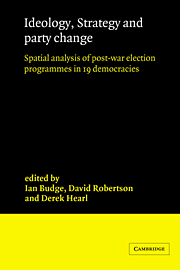 Ideology, Strategy and Party Change
Ideology, Strategy and Party Change Published online by Cambridge University Press: 27 October 2009
INTRODUCTION
Israel forms a self-contained case in terms of post-war elections, since the first national election to take place after independence was held in 1949. The party system however predated Israel's existence as an independent state. Earlier events also helped shape the constitution, which is unwritten, and derives its legitimacy from statute, precedent, custom and ideology. The most important statutes are the Transition Law of 1949, which provided the legal basis of government; the Law of Return of 1950, which affords any Jew the right of settlement in Israel; and the Basic Law, which is a series of enactments dating from 1948 which set out the fundamental rules of government. The British Mandate (1920–48) is of particular relevance for the way in which the party system developed.
Government is based on the principle of representative parliamentary democracy. Parliament, the supreme legislative organ, consists of a single chamber, the Knesset, composed of 120 members. The Executive consists of a cabinet which is formed on the basis of consultation between the State President and representatives of the political parties, and which has to submit to a vote of confidence by the Knesset. The Opposition can challenge the Executive at any time by calling for a motion of confidence. All governments in Israel have been coalitions, often involving a lengthy process of inter-party bargaining, which is controlled by the central committees of the parties involved.
To save this book to your Kindle, first ensure no-reply@cambridge.org is added to your Approved Personal Document E-mail List under your Personal Document Settings on the Manage Your Content and Devices page of your Amazon account. Then enter the ‘name’ part of your Kindle email address below. Find out more about saving to your Kindle.
Note you can select to save to either the @free.kindle.com or @kindle.com variations. ‘@free.kindle.com’ emails are free but can only be saved to your device when it is connected to wi-fi. ‘@kindle.com’ emails can be delivered even when you are not connected to wi-fi, but note that service fees apply.
Find out more about the Kindle Personal Document Service.
To save content items to your account, please confirm that you agree to abide by our usage policies. If this is the first time you use this feature, you will be asked to authorise Cambridge Core to connect with your account. Find out more about saving content to Dropbox.
To save content items to your account, please confirm that you agree to abide by our usage policies. If this is the first time you use this feature, you will be asked to authorise Cambridge Core to connect with your account. Find out more about saving content to Google Drive.